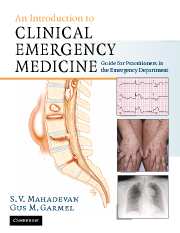Book contents
- Frontmatter
- Contents
- List of contributors
- Foreword
- Acknowledgments
- Dedication
- Section 1 Principles of Emergency Medicine
- Section 2 Primary Complaints
- 9 Abdominal pain
- 10 Abnormal behavior
- 11 Allergic reactions and anaphylactic syndromes
- 12 Altered mental status
- 13 Chest pain
- 14 Constipation
- 15 Crying and irritability
- 16 Diabetes-related emergencies
- 17 Diarrhea
- 18 Dizziness and vertigo
- 19 Ear pain, nosebleed and throat pain (ENT)
- 20 Extremity trauma
- 21 Eye pain, redness and visual loss
- 22 Fever in adults
- 23 Fever in children
- 24 Gastrointestinal bleeding
- 25 Headache
- 26 Hypertensive urgencies and emergencies
- 27 Joint pain
- 28 Low back pain
- 29 Pelvic pain
- 30 Rash
- 31 Scrotal pain
- 32 Seizures
- 33 Shortness of breath in adults
- 34 Shortness of breath in children
- 35 Syncope
- 36 Toxicologic emergencies
- 37 Urinary-related complaints
- 38 Vaginal bleeding
- 39 Vomiting
- 40 Weakness
- Section 3 Unique Issues in Emergency Medicine
- Section 4 Appendices
- Index
26 - Hypertensive urgencies and emergencies
Published online by Cambridge University Press: 27 October 2009
- Frontmatter
- Contents
- List of contributors
- Foreword
- Acknowledgments
- Dedication
- Section 1 Principles of Emergency Medicine
- Section 2 Primary Complaints
- 9 Abdominal pain
- 10 Abnormal behavior
- 11 Allergic reactions and anaphylactic syndromes
- 12 Altered mental status
- 13 Chest pain
- 14 Constipation
- 15 Crying and irritability
- 16 Diabetes-related emergencies
- 17 Diarrhea
- 18 Dizziness and vertigo
- 19 Ear pain, nosebleed and throat pain (ENT)
- 20 Extremity trauma
- 21 Eye pain, redness and visual loss
- 22 Fever in adults
- 23 Fever in children
- 24 Gastrointestinal bleeding
- 25 Headache
- 26 Hypertensive urgencies and emergencies
- 27 Joint pain
- 28 Low back pain
- 29 Pelvic pain
- 30 Rash
- 31 Scrotal pain
- 32 Seizures
- 33 Shortness of breath in adults
- 34 Shortness of breath in children
- 35 Syncope
- 36 Toxicologic emergencies
- 37 Urinary-related complaints
- 38 Vaginal bleeding
- 39 Vomiting
- 40 Weakness
- Section 3 Unique Issues in Emergency Medicine
- Section 4 Appendices
- Index
Summary
Scope of the problem
Hypertension (HTN) affects more than 20% of the adult and 3% of the pediatric populations. It is a disease process that contributes to the development of cardiovascular and renal diseases. It appears to be a polygenic, multifactorial disorder with several genes interacting with environmental factors. It is defined by a systolic blood pressure (SBP) greater than 140, diastolic blood pressure (DBP) greater than 90, or someone requiring antihypertensive medications for control of sustained elevations of blood pressure (BP).
As a disease process, HTN was born out of epidemiological studies that showed chronic BP elevation decreased life expectancy; that treatment of HTN reduces stroke, coronary artery disease (CAD), and heart failure; and that most hypertensive patients require more than one agent to achieve BP control.
HTN is an asymptomatic disease process. The exception is a hypertensive emergency. Hypertensive emergencies and urgencies, also known as hypertensive crises, can cause end-organ dysfunction and require controlled management. These hypertensive crises can be viewed as a continuum of the disease process in some patients.
A hypertensive emergency, also known as malignant HTN, is defined as an acute elevation in BP (DBP >130 mmHg in general) with end-organ dysfunction or damage. It requires prompt parenteral treatment with a goal of 25% reduction in mean arterial pressure (MAP) within 30–60 minutes.
A hypertensive urgency is defined as moderately severe to severe HTN with DBP 120–140 mmHg without presenting signs or symptoms of malignant HTN or a concomitant emergency medical condition.
- Type
- Chapter
- Information
- An Introduction to Clinical Emergency MedicineGuide for Practitioners in the Emergency Department, pp. 393 - 400Publisher: Cambridge University PressPrint publication year: 2005



